Menu
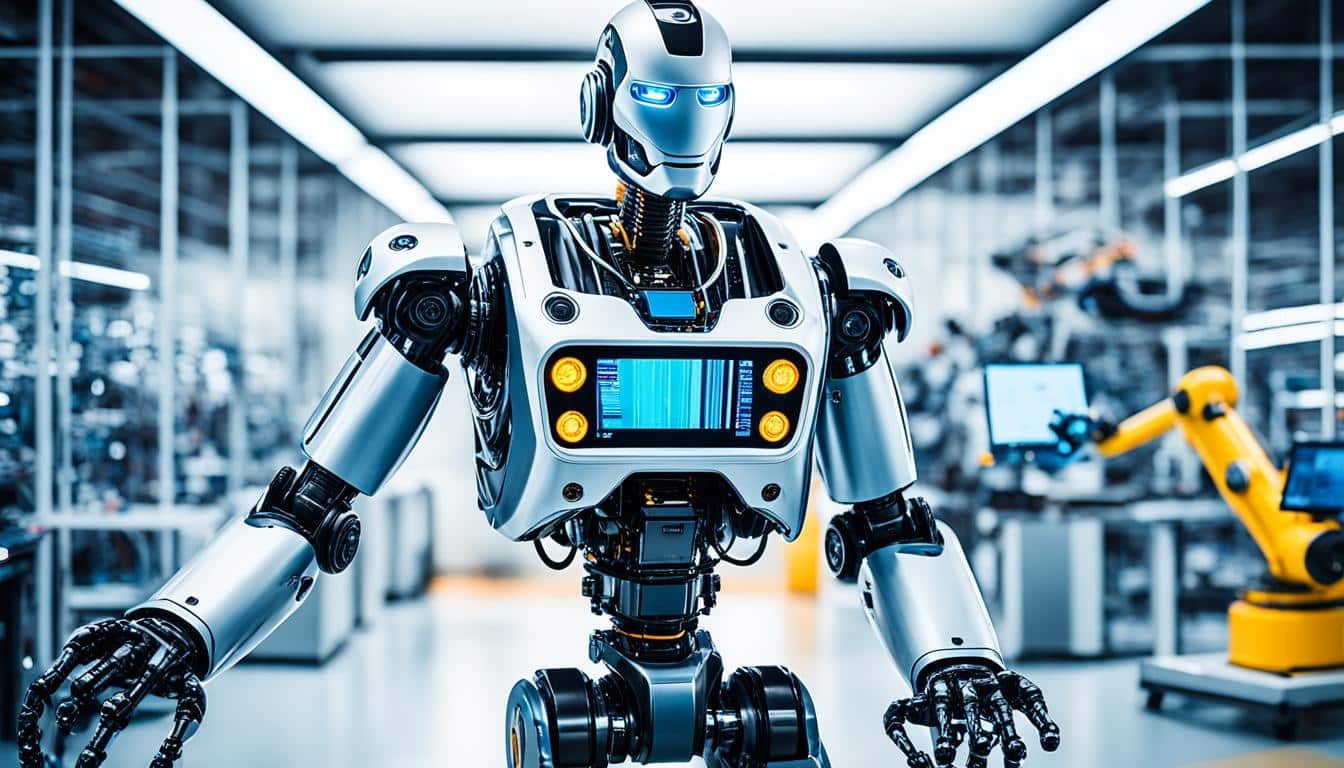
Did you know one-on-one tutoring is really helpful? Both Bloom (1984) and Chi et al. (2001) agree. This is even more true with today’s AI and robotics advances. Interactive case studies show how these new technologies can change learning.
AI has changed many fields, like space exploration and education. But, it faces challenges too. GenAI might make mistakes and stop in longer talks. Students then need to figure things out on their own.
Making case study prompts is hard work. It needs a lot of details to tell the story right. Some use Breen’s ideas, others create brand new instructions. These studies show how AI and robotics are making big changes in education, healthcare, and more.
In recent years, AI and robotics have joined hands to change our world. This innovation has made industries work better and smarter. This AI project showcase shows how big the impact is when these technologies come together.
AI and robotics coming together have brought us amazing advancements. Machines now learn and decide things like humans do because of AI models. They can see and understand their surroundings in new ways thanks to a wide range of sensors.
This union has proven its worth, especially in the fight against COVID-19. AI and robotics have helped make cities smarter and safer during the pandemic. They’ve done this by being able to handle tasks quickly and in tailored ways.
The growth of AI and robotics is mind-blowing. Machine learning is making robots smarter and more adaptable. The World Economic Forum predicts they will create more jobs than they take away by 2025.
People working in robotics have a very important job. They make and look after machines that are essential in areas like making things, healthcare, and space. This fast advance is seen in many artificial intelligence studies that showcase what these technologies can do.
In the end, the mix of AI and robotics is a top theme in today’s tech world. Looking at different studies and uses, it’s clear these developments do more than just change how things work. They change our relationship with technology.
We need to start with the core of AI and what it’s all about to see the magic when AI and robotics work together. This basic knowledge is a jump-off point to see their combined power.
Artificial Intelligence (AI) is the way machines copy human intelligence. They can think, learn, and adjust. This covers various tasks, like understanding language (NLP) and learning from data. In fields like customer service and industry, AI is making big changes. It’s doing this by using tasks like chatting with us online or helping produce goods.
Robotics is about creating robots that can work on their own or with a little human help. It takes a lot of skills in coding and problem-solving to work in this field. As of February 2023, the average pay for someone in robotics is $100,205 a year. Robots are vital in making products, keeping us safe, exploring space, and even in hospitals.
When AI and robotics join forces, they boost each other’s powers. AI brings brains to robots, letting them do more complex work by themselves. This has shown huge benefits, like in packaging and advanced manufacturing. With both AI and robots working together, they will create more jobs than they will take away. By 2025, they’re expected to bring about 12 million new jobs.
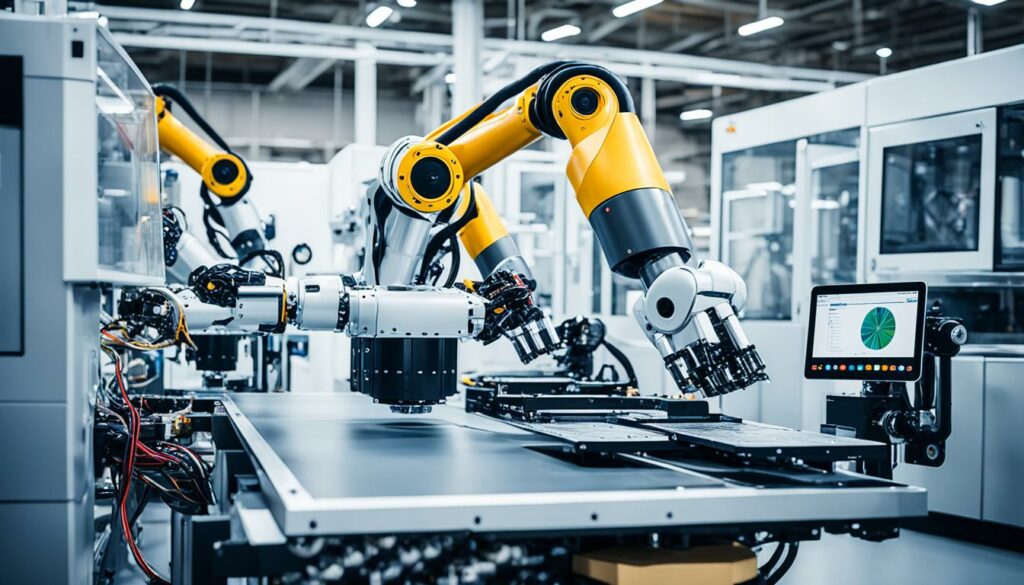
Artificial Intelligence (AI) and robotics are changing higher education. A widely read research paper shows their growing impact. They bring both new opportunities and some challenges to schools and universities.
AI can tailor learning to each student, meeting their specific needs. It also creates learning environments that can adjust to how students are doing. Teachers using AI can study how well students are learning, helping them teach better.
AI tools also make teaching more effective. This means teachers can spend more time on the creative parts of teaching.
Robots in administrative tasks can make a campus operate more smoothly. They help with things like scheduling and handling data. This makes things easier for the people working at the university.
Combining AI with robots in these tasks leads to better-run schools. It frees up staff to do more important work in other areas.
Using AI in education raises some ethical questions. We must think about how we protect student data and ensure fairness. A mix of knowledge from teaching and ethics is needed to tackle these issues.
Tackling these challenges is key to using AI and robotics wisely in education.
AI and robotics are key in helping during disasters, making search and rescue, prediction and planning better. They are at the forefront, reducing the harm of natural and human disasters. We will explore how these techs are crucial in emergencies.
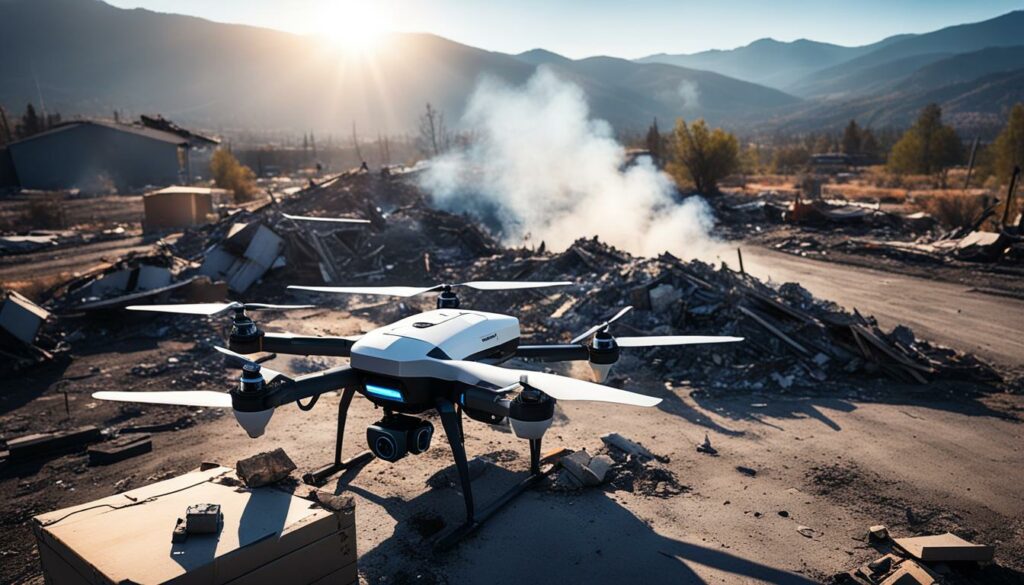
Rescue robots have vastly improved how we search for and save people. They can go places too dangerous for humans, using AI to navigate. They use advanced tech to find survivors quickly and offer help. Thanks to robots like Boston Dynamics’ Spot and drones, the way we handle disasters is changing.
AI is key in looking ahead and preparing for disasters. It analyses lots of data to predict what might happen and suggest actions before it’s too late. This helps with identifying risky areas or forecasting hurricanes, meaning people can be warned and resources sent. Automated case studies are critical in showing the benefits of such AI use.
Looking at examples like Japan’s 2011 disaster, robots aided in searching and checking radiation. In California, drones with special tech helped to fight wildfires by spotting hotspots. They proved crucial in managing the fire and organising firefighting.
| Region | Deployment | Technology Used | Impact |
|---|---|---|---|
| Japan | Post-earthquake and tsunami response | Rescue robots, radiation detection robots | Enhanced survivor location and area safety |
| California | Wildfire management | AI-driven drones, thermal imaging | Improved firefighting coordination, reduced wildfire spread |
AI and robotics are changing healthcare. They make surgeries more precise and improve patient care. They also help hospitals stay clean and fight infection.
Robots are now part of surgical teams, bringing pinpoint precision. The Da Vinci Surgical System is a star here. It reduces mistakes and quickens recovery. The Mayo Clinic and Google Cloud have teamed up to predict breast cancer risk with AI. This shows how robots can make surgeries better.
In hospitals, robots are helping with patient care. They watch patients and gather data for doctors and nurses. At Valley Medical Center, the CORTEX® system boosted review speed by 67%. Now, reviews are always completed. This shows how robots speed up and improve care.
Clean hospitals are critical, especially since COVID-19. AI-powered disinfection robots are key. At TidalHealth Peninsula Regional, search times dropped a lot. Now, with robots, clinics are cleaner and safer for everyone.
| Institution | Application | Outcome |
|---|---|---|
| Mayo Clinic and Google Cloud | AI breast cancer risk assessment | Automatic in-depth calculations and risk assessment |
| Valley Medical Center | Implementation of CORTEX® | 67% improvement in case review volume |
| TidalHealth Peninsula Regional | Clinical search with AI | Reduction in search time to less than 1 minute |
Advances in AI and robotics are changing farming. They bring new solutions to boost productivity and care for the environment. They include automation, smarter predictions, and high-tech machines, leading a new wave in how we farm.
Robots are now doing jobs that take a lot of effort on farms. By 2050, farms could collect 4.1 million pieces of data every day. These machines help with jobs like planting, watering, and adding fertiliser. They use special sensors and GPS to do these tasks better. This means less need for people to step in. It raises how much we can grow and cuts down on how many chemicals we use. For example, precision spraying can cut chemical use by up to 80%. This shows how good robots are for the planet.

Analytics that predict farming needs are vital today. They look at soil health and weather info to find the best times for planting and harvesting. This helps make sure we grow as much as we can. It also helps us match what we grow with what people want to buy. Using these predictions makes farming more effective. It means better crops, faster delivery, and less waste.
New tools like Dexterous Hand and LaserWeeder are changing indoor farming. They make it possible to grow 10 times more in the same space. Dexterous hands handle jobs too tricky for regular machines. LaserWeeder takes care of weeds without harming the soil with chemicals. These tools show the big impact robots can have on how well we farm.
Here are some big numbers about how AI and robotics are helping in agriculture:
| Metric | Impact |
|---|---|
| Data Points Generated by 2050 | 4.1 million per day |
| Reduction in Chemical Use | Up to 80% |
| Yield Increase in Indoor Farming | 10x |
| AI Technology Applications | Planting, Watering, Fertilizing, Weed Control |
There are still hurdles to cross, like making sure all farms can connect to the internet and have enough power. But, automation in agriculture is pushing the whole farming world forward.
Today, the construction industry is changing fast. It’s using AI and robotics to work smarter and safer. Robots are tackling the jobs humans find difficult. This not only makes our construction sites safer but also makes our buildings better and faster to build.
Imagine robots laying bricks perfectly, pouring concrete without a break, and handling materials with ease. This is now a reality. Risong Technology’s platform shows how machines and the internet can work well together. They cut down on mistakes and keep things running smoothly.
Working in construction can be dangerous. But with the help of robots, we can make sites safer. AI lets us watch over things in real-time and predicts risks. This keeps us safe and our work top-notch. AI and sensors help robots stop accidents before they happen. This is a big step in keeping everyone safe on the job.
The Hadrian X from Fastbrick Robotics is a game-changer. It lays bricks exactly where they need to go, without rest, showing us what’s possible with robots. It can lay up to 1,000 bricks in an hour. This speeds up building work and makes every brick wall look the same. A clear win for quality and speed in construction.
Here’s some important info to remember about how these new technologies help:
| Advancements | Impact | Example |
|---|---|---|
| Automation in Labour-Intensive Tasks | Increased Productivity and Efficiency | Hadrian X |
| Enhanced Safety Measures | Reduced Workplace Accidents | AI-driven Monitoring Systems |
| Precision in Project Execution | Consistent and High-Quality Output | Robotic Bricklaying |
AI and robotics are changing many industries, making work faster and cheaper. In this article, I will show you how these techs are changing things in manufacturing, aerospace, and transportation.
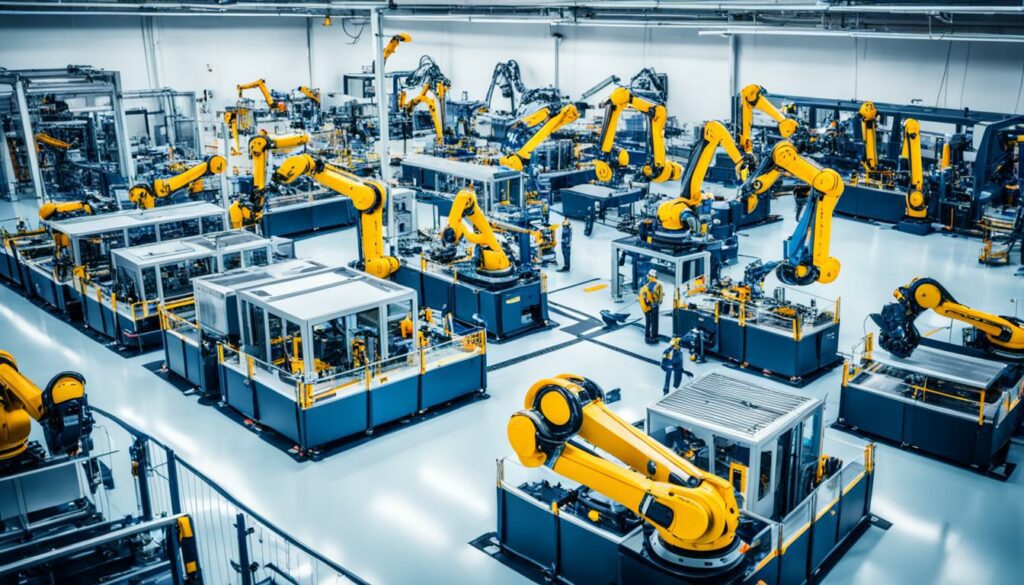
In manufacturing, using Robotic Process Automation (RPA) has had big results. For instance, a technology company automated how it hires people, saving over $90,000 each year. RPA also cut the company’s overall costs by 40% by handling back-office tasks. This shows how robots in different industries can improve how a business runs.
The aerospace field is improving thanks to AI and robotics. Companies use AI to predict when equipment might break, lowering downtime and costs. These innovations in aerospace keep flights safe and efficient.
AI and robotics have also changed how things move from place to place. RPA has made paying bills a lot faster and easier, cutting TAT by 67% and saving 83% of the work. In the insurance world, the use of these techs means processing payments 220% faster and with no mistakes. This shows how automated transportation processes can be both fast and correct.
As the global Robotic Process Automation (RPA) market is projected to reach USD 30.85 billion by 2030, with a Compounded Annual Growth Rate (CAGR) of 39.9% from 2023 to 2030, it’s clear that the integration of AI and robotics will continue to revolutionise these industries further.
AI and robotics are changing how we make things, making manufacturing more efficient and controlled. They help manage waste better, too. These technologies boost productivity and spark new ideas, making work easier for everyone.
Manufacturing has become much more efficient with AI and robots. Risong Technology’s cloud platform simplifies operations, making manufacturing join the Internet world. The BMW Group saves a lot of money each year by using AI to control robots that weld car parts correctly. This happens in the Spartanburg plant, where they make more than 1,500 cars every day.
In industrial laundries, machines can process 100 tons of laundry a day without needing much help. This shows us how powerful AI is in making manufacturing smooth.
High quality in manufacturing is key. AI and robots play a big role in making sure products are top-notch. General Motors uses AI to look at images from robots that build cars to find problems early. This can save them a lot of money for every minute their production line is down.
Another cool technology is AI that tells where things are, helping set up machines faster for making lots of something. This makes sure products are made just right every time.
In handling dangerous waste, AI and robotics are also crucial. FANUC and Recycleye work together to sort waste safely and efficiently. Their work supports a big global goal. By using robots to pick out recyclables, they are making waste management smarter.
Nissan is a leader in using AI and robots in manufacturing. They automate tough jobs and focus on making their factories not harm the environment. This shows how AI can make all parts of manufacturing better together.
| Company | Initiative | Outcome |
|---|---|---|
| BMW Group | AI-managed robots for welding | $1 million saved annually, 1,500 vehicles produced daily |
| General Motors | AI image analysis for assembly robots | $20,000 per minute of assembly line stoppage prevented |
| Risong Technology | Cloud platform for operation and maintenance | Accelerated manufacturing and Internet integration |
| FANUC and Recycleye | Robotic picking systems for waste management | Enhanced safety, supporting UN Sustainability Goal No 11 |
Integrating AI and robotics in smart homes changes how we live. These technologies bring better automation, help from personal assistants, and improved security. This makes places we live in not just smarter but also more efficient.
Smart home tech, powered by AI, lets us control our homes without much effort. It can do things like control lights, the temperature, and what you watch or listen to. It learns your habits and helps save energy, which can lower your bills over time.
In smart homes, robots like Amazon’s Astro and iRobot’s Roomba are making life easier. They do tasks like cleaning up, keeping an eye on things, and even offering some company. This transforms our living spaces into places that feel much more comfortable.
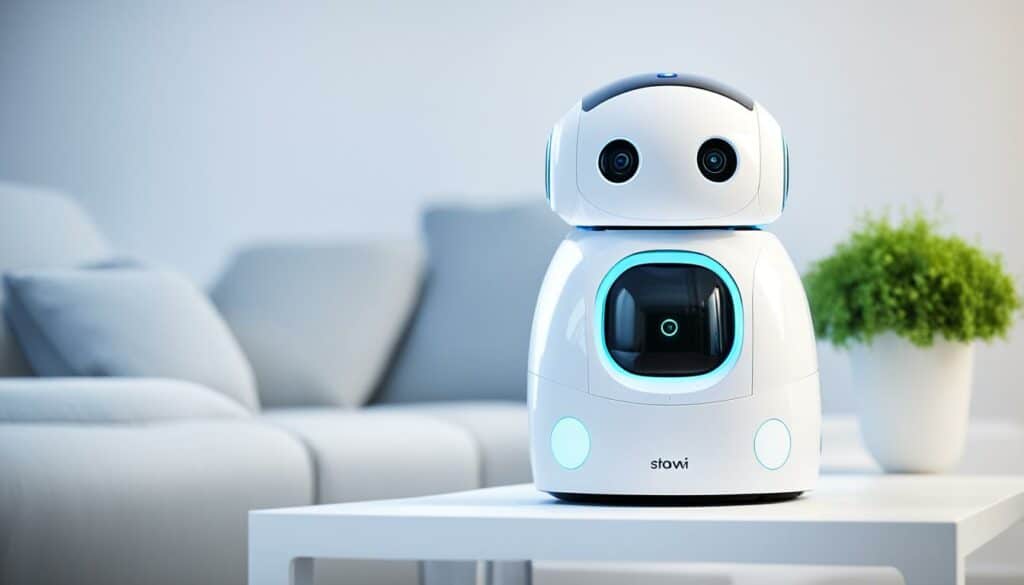
AI-backed security brings a new level of safety to our homes. It uses smart cameras and sensors to spot any unusual activities. This real-time alert system can help prevent threats, making our homes safer places.
| Sector | Benefits | Examples |
|---|---|---|
| Home Automation | Energy Efficiency, User Convenience | Climate Control, Smart Lighting |
| Personal Assistance | Task Automation, Enhanced Comfort | Amazon Astro, iRobot Roomba |
| Security and Surveillance | Increased Safety, Real-time Monitoring | Smart Cameras, Motion Sensors |
AI and robotics are changing wildlife conservation for the better. They introduce new tools and skills never seen before. These technologies let us follow, watch, and safeguard animals in new, smarter ways.
Using robots, scientists can keep a closer eye on animals. They can fly drones to watch animals from above. The World Wildlife Fund uses robotic drones, called SnotBots. They collect whale snot to study sei whales.
These robot systems use advanced tech like Lidar and machine learning. They help us take better care of our animal friends by checking their homes.
AI against poaching is a big step for saving endangered animals. It uses secret sensors and flying drones to stop hunters. Thanks to partnerships like Intel and the WWF, we can track Siberian tigers to protect them better. This helps stop poaching by giving us important information.
Systems with AI and robotics keep an eye on nature. For example, there are robots that look like sloths. They check on plants and animals, telling us what’s happening now. This information is key for making choices to save nature and its residents.
With these smart technologies, not only animals but also their homes are looked after. They offer a way to watch and study nature all the time. This is how we keep nature healthy for the future.
| Technology | Application | Impact |
|---|---|---|
| SnotBots | Collecting whale snot | Monitoring whale populations |
| Anti-poaching AI | Tracking Siberian tigers | Reducing illegal poaching |
| Solar-powered robots | Monitoring plant and animal activity | Preservation of natural habitats |
To sum up, AI and robotics are a new hope for wildlife. They offer fresh ways to watch and protect animals and their homes. This helps ensure a safe future for all.
AI and robotics are changing how we shop, making things better and easier. They help in handling customer questions fast, managing products, and making our shopping experiences great. For shops to keep up in the changing world, they need to use these new technologies more and more.
New tech is making it easy for shops to talk with us better. For example, chatbots chat with us online, take orders, and even give advice. This new way of working not only makes things quicker but also makes us, the customers, happier. A study showed that when chatbots act more like people, it feels better for us customers when we talk to them. This is because we like it when things feel more friendly and human-like.
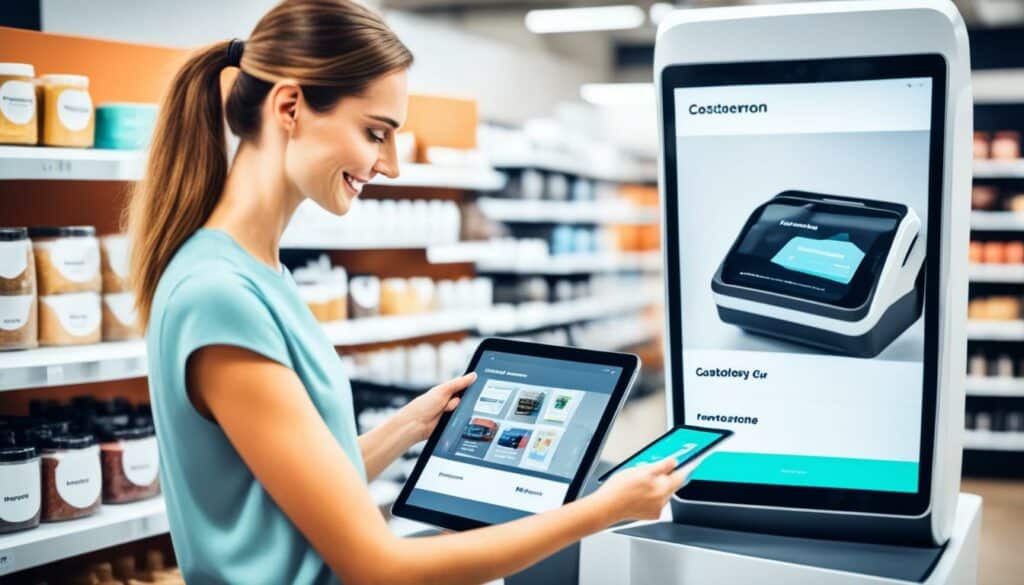
Keeping track of products is getting smarter because of AI. It forecasts what we might want to buy, keeps the right stock, and makes sure everything stays up to date. Big names like Amazon are using cool robots, like Sequoia, to help out in their warehouses. This makes them work better and keeps everything safe. Also, Office Depot is using smart robots that move around to help pick items faster. With these new tools, shops are able to make us, the customers, happy by always having what we want in stock.
Shops are working hard to make us enjoy shopping more with AI. Now, you can chat by talking to your shopping app or a device at home. This makes shopping feel smooth and easy. IBM Watson, for example, uses powerful tech to answer our shopping questions and suggest things we might like. Thanks to such tools, stores are getting much better at knowing what we want. For example, 1-800-Flowers.com saw more people buying online after they introduced an AI assistant to help customers pick the best gifts. This shows how AI is changing the game in making us, the shoppers, happy.
| Aspect | Impact |
|---|---|
| Automated Customer Service | Handling inquiries, processing orders, and offering personalised recommendations |
| Stock Management AI | Predicting demand, managing inventory levels, and streamlining replenishment |
| Customer Experience Improvements | Creating flow-like experiences and offering personalised shopping assistance |
AI and robotics are growing fast. This brings up many ethical and legal issues. We talk about AI data privacy, being fair, and setting solid rules.
Data safety is a big issue for AI and robotics. Health data is especially private. More healthcare groups are spending on keeping it safe from hackers. As AI tech gathers more data, the worries about privacy grow.
Fairness in AI, especially in healthcare, is a major issue. Research shows AI can sometimes give unfair results, especially for minority groups. We need to test AI models well and make their workings clear. Also, healthcare workers need to learn more about AI to spot and fix bias. U.S. agencies want to stop discrimination caused by AI.
We must make clear laws for AI and robots. It’s tough to decide who’s to blame if AI causes harm. The European Commission and others have set AI ethics rules. These say AI should be open, fair, and accountable. We need to train healthcare staff more about new tech. The White House has also given funds to tackle AI ethics.
| Challenge | Key Statistic |
|---|---|
| Algorithmic Bias in Healthcare | Significant occurrence rate in minority groups |
| Investment in Cybersecurity Measures | A high percentage of healthcare organisations |
| Digital Literacy Among Healthcare Professionals | Moderate ratio, highlighting training necessity |
| Legal Liability Issues | Complex occurrence rate in AI-related mishaps |
The future of AI and robotics looks really exciting. New future AI trends and robotics innovations are making big changes. We’re heading into a world where technology will change our lives in many ways.
AI and robotics are coming together to create amazing things. Boston Dynamics has made robots like Atlas and Spot for tough jobs. In health, the da Vinci Surgical System by Intuitive Surgical shows how AI is changing things.
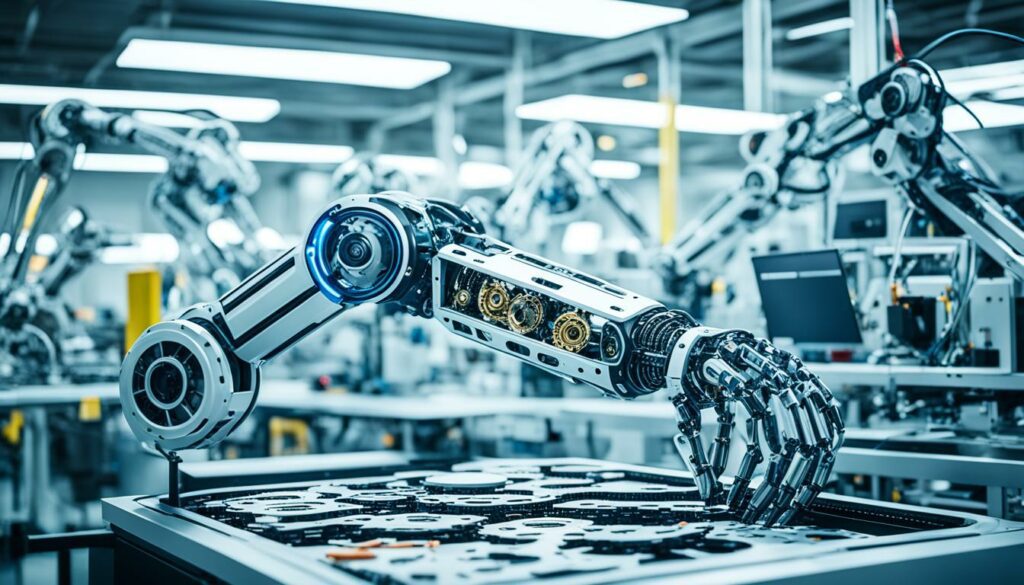
In manufacturing, using machine learning to improve how robots work is a big trend. For example, Amazon uses Kiva robots to manage their stock better. This shows how AI can make complex choices.
People think AI and robots could take away some jobs, according to some studies. But others say new jobs will be made faster than old ones are lost. It’s a big question about what will happen.
There are worries about if our schools are teaching the right things for future jobs. People like Jonathan Grudin and Glenn Edens believe we need new jobs that only humans can do. They say this will keep our economies strong.
We might see big changes because of AI and robots in places like home maintenance. At work, things like AI quality checks and predictive maintenance will likely become very common.
There are still big issues about ethics and job loss from AI. But, new jobs are also being made. Andrew Rens says making new jobs is important for our economies.
The aim of all these changes is not just to have new tech but to use it well in our society. The future will depend on how we use and balance these new technologies for the good of everyone.
The journey through AI and robotics shows us their big role in change. They help in hospitals, disaster relief, and more. We see their impact in healthcare through AI in diagnosis, robots in surgery, and patient tracking.
We also learn that using research shows the good of these new tools. It makes patients better, work smoother, and saves money. This is why many fields are starting to use AI and robots. They help the planet and are used the right way in medicine.
But, there are challenges ahead. The study found many gaps to fill. Things like staying green, working well with people, and being fair to patients need more thought. Also, keeping data safe, job changes, and fairness in how decisions are made are big issues.
Looking at cases, we know more work is needed. We must tackle tricky ethics to keep these technologies improving and being good for everyone. Solving these problems is the key to AI and robotics being a lasting success that everyone supports.
Key case studies show robotic surgeries in healthcare and robots aiding in disasters. The LaserWeeder in farming is another big one. These areas have seen major change due to new technology.
They team up well. AI learns and decides, while robots act physically. Their teamwork brings us self-driving machines and smart robot systems. These advances help in many fields.
Artificial intelligence makes machines act like us. It lets them learn and solve problems. Robotics is about creating robots to work by themselves or with some help, too.
They’re changing teaching, helping run schools, and raising big questions. For example, we see robots assisting teachers and smart tools for each student’s unique learning. This is changing how we learn.
They’re great in disasters by finding survivors, predicting future troubles, and coordinating responses. Japan’s quake and the California fires show their power, yet also the hurdles they face.
Healthcare uses them for surgeries to make things more precise. There are also devices that look after patients and keep things clean. These help make medicine better for everyone.
In farming, they take on hard work, boost crops, and use cool tools like Dexterous Hand. The LaserWeeder is another favourite. They’re all about making farms work better and produce more.
They’re changing how we build by doing jobs people used to. Safety and precision get a big boost. Fastbrick Robotics’ Hadrian X shows what they can do in construction.
Industries have done better with neat and precise production lines, space breakthroughs, and smart transportation. These stories show how they are enhancing our work and making things smoother.
In smart houses, they’re in charge of making things easy, looking out for us, and keeping the place safe. Our homes are becoming more clever and secure thanks to them.
They help protect our wildlife with smart tracking, stopping poachers, and keeping their homes safe. These tools are essential in saving endangered animals and their homes.
They’re making shops and service better by doing some jobs for us, stocking goods, and upping customer care. They offer quick help that makes shopping and service smoother and nicer.
They raise concerns about privacy, fair algorithms, and rules that need to catch up. Dealing with these issues is key to using AI and robots in ways that are safe and just.
Tomorrow’s AI and robots will likely introduce new ways to live and work. We’re guessing at their future roles, but we know they’ll keep changing our world in big ways.